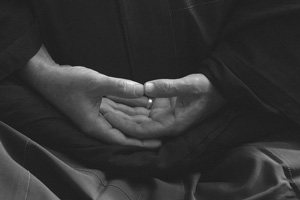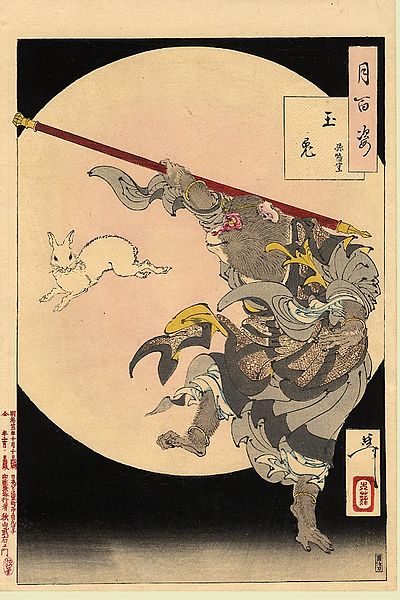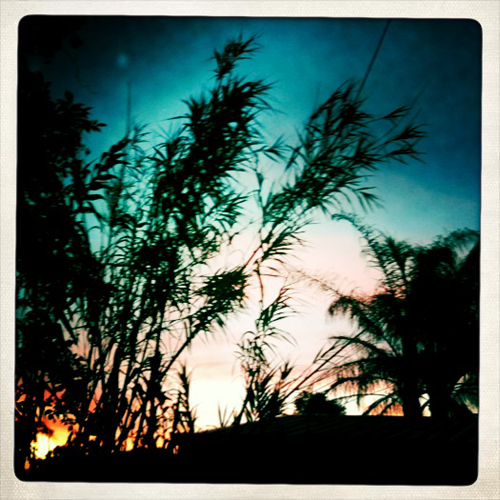"When you light the fire of wisdom, you warm the pure water of the
precepts and bathe the true Buddha nature within you." - The First Zen Patriarch Bodhidharma (early 5th century AD), Breakthrough Sermon.
In
Part 1 I discussed various mindfulness teachings on the positive role of the water element in mindfulness practice. This time I am going to present various metaphorical examples from mindfulness teachers using the fire element and how it interacts with the water element.
 |
| Indonesian Buddhist monks obtaining fire from the undying Mrapen flame, Java. |
In Manggarmas Village, Godong District, Grobogan regency, Central Java Province, Indonesia, there is a flame that never goes out - even when storms ravage the islands. It is a natural geological phenomenon consisting of flammable gas escaping from the Earth's surface which was set alight (most likely by accident) more than 400 years ago. The locals call it the
Mrapen and it is used during ceremonies as a symbol of humanity's undying spirit. Beyond symbolic uses, however, fire has been a practical tool for humans for thousands of years. Discovering how to make fire significantly changed human societies, but we did not always have to make it - it could be taken from active volcanic areas.
 |
| A Tanna guide showing how to take fire from a volcano, Vanuatu Islands. |
Another by-product of volcanic activity bringing natural heat to the surface of the Earth is hot springs. These pools even today continue to provide us with a resource to enjoy in various ways, and it is this kind of basic elemental interaction between fire and water which has inspired so many mindfulness teachers to produce teachings using these two opposite natural forces as metaphors.
 |
| Japanese Macaque monkeys taking refuge in a hot spring in sub-zero temperatures. |
Reducing the various aspects of nature down to a handful of
elemental forces was a feature of classical Greek, Indian, and Chinese philosophy. Buddhism engaged in such a practice, as is outlined by Vietnamese Zen teacher
Thich Nhat Hanh in his book
The Heart of Buddha's Teaching (1998), p69:
"The third method the Buddha offered for practicing mindfulness of the body in the body is to see the elements that it is made of: earth, water, fire, and air. "Breathing in, I see the earth element in me. Breathing out, I smile to the earth element in me." "Earth element" refers to things that are solid. When we see the earth element inside and outside of us, we realize that there is really no boundary between us and the rest of the universe. Next, we recognize the water element inside and outside of us. "Breathing in, I am aware of the element of water in my body." We meditate on the fact that our body is more than seventy percent water. After that, we recognize the fire element, which means heat, inside and outside of us. For life to be possible, there must be heat. Practicing this, we see over and over that the elements inside and outside our body belong to the same reality, and we are no longer confined by our body. We are everywhere."

"In the darkness the branching streams flow everywhere, like water.
Even when you are not aware of water, there is water. Water is inside
our physical body and in plants too; there is water all over. In the
same way the pure source is everywhere."
It seems it is in the nature of water to contain everything within it -
even fire, and maybe it is this receptiveness of water to fire which
lies at the root of some of the most useful mindfulness meditation
metaphors. Suzuki goes on to illustrate the role of fire relative to water thus, p85:
"The
nature of fire is to purify. [...] The nature of water is to contain
things. Wherever you go there is water; water contains everything. This
is opposite to the usual way of thinking about water. Instead of saying
there is water in the trunk of the tree, we say that water contains the
trunk of the tree as well as the leaves and branches. So water is
something vast in which everything, including ourselves, exists."
It is also in the nature of water to move downwards, and for fire to move upwards, and these two opposite directions seem to create a kind of antagonistic tension - like a burning, dynamic fire of awareness in our minds high in our being, and a lake of still cool water lower in our being - as if both elements are stretching the spine straight as one sits in mindful meditation.
American Zen teacher
Charlotte Joko Beck, in her book
Everyday Zen (1997), mentions harnessing one's fiery attention in order to cut through unhealthy conditioned behaviours, p32:
"Attention is the cutting, burning sword, and our practice is to use that sword as much as we can. None of us is very willing to use it; but when we do—even for a few minutes—some cutting and burning takes place."
Bodhidharma; the Indian/Persian travelling Buddhist monk who is often considered the first true Zen teacher, spoke alternatively, in his
Breakthrough Sermon, of the
Dharma [teachings] being like a fire housed within practitioner's body which is acting like a furnace:
"Those who seek enlightenment regard their bodies as the furnace, the
Dharma as the fire, wisdom as the craftsmanship, and the three sets of
precepts and six paramitas as the mold. They smelt and refine the true
buddha-nature within themselves and pour it into the mold formed by the
rules of discipline."
 |
| The 'cosmic flame mudra' often used in seated Zen meditation. |
This intensive burning, dissolving, and purifying of one's essence is described by various teachers in similar ways to Bodhidharma. Charlotte Joko Beck writes in
Everyday Zen (1997), p33-34:
"the main purpose of doing sesshin [prolonged sitting practice] is this burning out of thoughts by
the fire of attention, so that our lives can be dispassionate and
fundamentally unaffected by outward circumstances. [...] ...the
breathing deepens and, when the fire really burns, there’s nothing it
can’t consume. When the fire gets hot enough, there is no self, because
now the fire is consuming everything; there is no separation between
self and other."
Shunryu Suzuki talks of this process relative to our tendency to become attached to things, in
Zen Mind, Beginner's Mind (1995), p63
"we should not become attached to what we have done in some special sense. What we call "attachment" is just these traces of our thought and activity. In order not to leave any traces, when you do something, you should do it with your whole body and mind; you should be concentrated on what you do. You should do it completely, like a good bonfire. You should not be a smoky fire. You should burn yourself completely. If you do not burn yourself completely, a trace of yourself will be left in what you do. You will have something remaining which is not completely burned out. Zen activity is activity which is completely burned out, with nothing remaining but ashes. This is the goal of our practice."
 |
| The Hindu God Shiva dancing within intense flames. |
Thich Nhat Hanh places an emphasis on the transformative potential of the burning process of our 'spiritual fire' in
The Heart of Buddha's Teaching when he illustrates the Buddha's disciple Shariputra demonstrating his understanding to his teacher
, p200:
"[Shariptra said to the Buddha:]
"I have practiced to be more like fire. Fire burns everything,
the pure as well as the impure, the beautiful as well as the
distasteful, without grasping or aversion. If you throw flowers or
silk into it, it burns. If you throw old cloth and other foul-smelling
things into it, the fire will accept and burn everything. It does not
discriminate. Why? Because fire can receive, consume, and burn
everything offered to it. I have tried to practice like fire. I am able
to burn the things that are negative in order to transform them."
This transformation via fire is presented in more detail in the same book, p138:
"If I burn this sheet of paper, will I reduce it to nonbeing? No, it will just be transformed into smoke, heat, and ash. If we put the "continuation" of this sheet of paper into the garden, later, while practicing walking meditation, we may see a little flower and recognize it as the rebirth of the sheet of paper. The smoke will become part of a cloud in the sky, also to continue the adventure."
The transformation from useless to useful by skillfully harnessing fire has long been a theme in Chinese culture. The
Monkey King character, from the old Chinese story
Journey to the West, has red bloodshot eyes after having been cooked in
LaoZi's
eight-way trigram crucible in an attempt to turn him into an elixir of
immortality (since he had stolen and consumed LaoZi's special
immortality pills). This very popular story is based upon the historical phenomenon of Chinese Buddhist monks travelling westward to India to obtain purer Buddhist teachings.
 |
| The Monkey King with red eyes irritated by the smoke from LaoZi's crucible, from the story Journey to the West. |
The idea of transformation occurring via a heated pot can go all the way back to when humans first began cooking using pottery. Boiling food in water is one of the most simple and effective methods of cooking. Bodhidharma related the process of wisdom penetrating the
world to water being heated in a container in his
Breakthrough Sermon:
"wisdom... penetrates subject and object, just as fire warms water."
There is also a physical release that comes from boiling a pot of water - the
water is made lighter as it evaporates into the air. The author of
Meditation for Dummies (2006) writes of this process in relation to meditation, p86:
"You might say that
meditating is like lifting the lid on a boiling pot of soup — you create
space for the water to evaporate and relieve the pressure that has been
building up inside."
Mindfulness teacher
Dr Jon Kabat-Zinn uses a similar analogy in
The Mindful Way Through Depression (2007), although he writes of bubbles moving up through the heated water, p156:
"As mindfulness develops, we can more
and more observe thoughts and emotions as if they were bubbles rising
from the bottom of a pot of boiling water; we simply watch as they burst
at the surface."
In China the use of heated crucibles to change the physical makeup of objects went beyond the mere preparation of food, however - it formed the metaphorical and metaphysical premises underlying the practice of ancient
Chinese alchemy.
It seems likely that these
Daoist alchemical metaphysical and chemical practices involving the body were interwoven with, and were applied metaphorically to, Buddhist teachings during the formation of Zen in ancient China around 1500 years ago. However, since metaphysical complexity is not something mindfulness teachers have found useful, the transformative 'alchemical' potential of mainstream effective mindfulness practice has apparently remained, metaphorically, within the domain of cooking food.
 |
| A Chinese alchemist. |
Thich Nhat Hanh writes, in
The Miracle of Mindfulness (1987), of the transformation of food, when boiled in water, as being a useful metaphor to illustrate the effect of mindfulness meditation within our lives, p62:
"the objects of meditation must be realities that have real roots in yourselves - not just subjects of philosophical speculation. Each should be like a kind of food that must be cooked for a long time over a hot fire. We put it in a pot, cover it, and light the fire. The pot is ourselves and the heat used to cook is the power of concentration. The fuel comes from the continuous practice of mindfulness. Without enough heat the food will never be cooked. But once cooked, the food reveals its true nature and helps lead us to liberation."
He goes into more detail regarding the above metaphor and how exactly transformation takes place in our lives in
Peace is Every Step (2005), p62-63:
"We cannot eat raw potatoes, but we don’t throw them away just because they are raw. We know we can cook them. So, we put them into a pot of water, put a lid on, and put the pot on the fire. The fire is mindfulness, the practice of breathing consciously and focusing on our anger. The lid symbolizes our concentration, because it prevents the heat from going out of the pot. When we are practicing breathing in and out, looking into our anger, we need some concentration in order for our practice to be strong. Therefore, we turn away from all distractions and focus on the problem. If we go out into nature, among the trees and flowers, the practice is easier. As soon as we put the pot on the fire, a change occurs. The water begins to warm up. Ten minutes later, it boils, but we have to keep the fire going a while longer in order to cook our potatoes. As we practice being aware of our breathing and our anger, a transformation is already occurring. After half an hour, we lift the lid and smell something different. We know that we can eat our potatoes now. Anger has been transformed into another kind of energy—understanding and compassion."
 |
| Soup cooked in a bamboo section placed on a wood fire. |
This 'cooking process', independent of our efforts to have a regular discipline which enables us to sit down in mindfulness often enough, is effortless - it happens automatically. Kabat-Zinn mentions this aspect in his book
Wherever You Go, There You Are (2004), p94:
"Awareness itself does the cooking, as long as it is sustained. You just let the fragments stir while you hold them in awareness. Whatever
comes up in mind or body goes into the pot, becomes part of the soup."
And so we have a harmonious interaction between the antagonistic elements of fire and water - working together in harmony to transform and soften us as if we were a raw potato in a steamer, or a worn-out stiff-legged traveller recovering in a hot spring.
In amongst these metaphors, however, there is a lack of organic life in the mix - an apparently essential and more tangible source of inspiration for us as living organisms - and so next we will move to the role of fire as illuminator and nourisher, and water as a welcoming host to life - the sun above the lakes and ponds.... in
part 3.











No comments:
Post a Comment